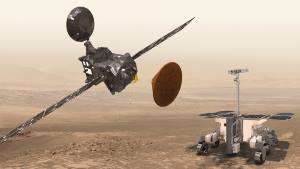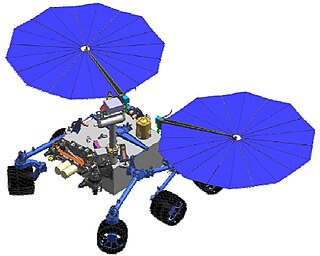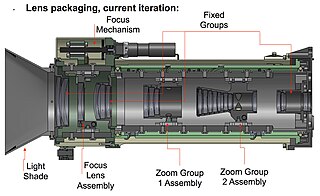A biosignature is any substance – such as an element, isotope, or molecule – or phenomenon that provides scientific evidence of past or present life. Measurable attributes of life include its complex physical or chemical structures and its use of free energy and the production of biomass and wastes. In essence, a biosignature is evidence for living organisms outside the Earth and can be directly or indirectly detected by searching for their unique byproducts.

ExoMars is a two-part astrobiology project to search for evidence of life on Mars, a joint mission of the European Space Agency (ESA) and the Russian space agency Roscosmos. The first part, launched in 2016, placed the Trace Gas Orbiter into Mars orbit and released the Schiaparelli EDM lander. The second part is planned to launch in July 2020, when the Kazachok lander will deliver the Rosalind Franklin rover on the surface, supporting a science mission that is expected to last into 2022 or beyond.

The Astrobiology Field Laboratory (AFL) was a proposed NASA unmanned spacecraft that would have conducted a robotic search for life on Mars. This proposed mission, which was not funded, would have landed a rover on Mars in 2016 and explore a site for habitat. Examples of such sites are an active or extinct hydrothermal deposit, a dry lake or a specific polar site.

The Mars Astrobiology Explorer-Cacher (MAX-C), also known as Mars 2018 mission was a NASA concept for a Mars rover mission, proposed to be launched in 2018 together with the European ExoMars rover. The MAX-C rover concept was cancelled in April 2011 due to budget cuts.
The Biological Oxidant and Life Detection (BOLD) is a concept mission to Mars focused on searching for evidence or biosignatures of microscopic life on Mars. The BOLD mission objective would be to quantify the amount of hydrogen peroxide existing in the Martian soil and to test for processes typically associated with life. Six landing packages are projected to impact 'softly' on Mars that include a limited power supply, a set of oxidant and life detection experiments, and a transmitter, which is able to transmit information via an existing Mars orbiter back to Earth. The mission was first proposed in 2012.

Each Pancam is one of two electronic stereo cameras on Mars Exploration Rovers Spirit and Opportunity. It has a filter wheel assembly that enables it to view different wavelengths of light and the pair of Pancams are mounted beside two NavCams on the MER camera bar assembly.

Navcam, short for navigational camera, is a type of camera found on certain robotic rovers or spacecraft used for navigation without interfering with scientific instruments. Navcams typically take wide angle photographs that are used to plan the next moves of the vehicle or object tracking.
ExoLance is a low-cost mission concept that could hitch a ride on other missions to Mars in an effort to look for evidence of subsurface life.
Scanning Habitable Environments with Raman and Luminescence for Organics and Chemicals (SHERLOC) is an ultraviolet Raman spectrometer that uses fine-scale imaging and an ultraviolet (UV) laser to determine fine-scale mineralogy and detect organic compounds designed for the Mars 2020 rover mission. It is constructed at the Jet Propulsion Laboratory with major subsystems being delivered from Malin Space Science Systems and Los Alamos National Laboratory. The Principal Investigator is Luther Beegle, and the Deputy Principal Investigator is Rohit Bhartia.

Mastcam-Z is a multispectral, stereoscopic imaging instrument selected by NASA for the upcoming Mars 2020 rover mission. The Principal Investigator is Jim Bell of Arizona State University. The instrument will be built by Malin Space Science Systems in San Diego, California.
The Mars Organic Molecule Analyser (MOMA) is a mass spectrometer-based instrument on board the Rosalind Franklin rover to be launched in July 2020 to Mars on an astrobiology mission. It will search for organic compounds in the collected soil samples. By characterizing the molecular structures of detected organics, MOMA can provide insights into potential molecular biosignatures. MOMA will be able to detect organic molecules at concentrations as low as 10 parts-per-billion by weight (ppbw). MOMA examines solid crushed samples exclusively; it does not perform atmospheric analyses.
Mars Multispectral Imager for Subsurface Studies (MA-MISS) is a miniaturized imaging spectrometer designed to provide imaging and spectra by reflectance in the near-infrared (NIR) wavelength region and determine the mineral composition and stratigraphy. The instrument is part of the science payload onboard the European Rosalind Franklin rover, tasked to search for biosignatures, and scheduled to land on Mars in 2021. MA-MISS is essentially inside a drill on the Rover, and will take measurements of the sub-surface directly.

MicrOmega-IR is an infrared hyperspectral microscope that is part of the science payload on board the European Rosalind Franklin rover, tasked to search for biosignatures on Mars. The rover is planned to land on Mars in 2021. MicrOmega-IR will analyse in situ the powder material derived from crushed samples collected by the rover's core drill.
Raman Laser Spectrometer (RLS) is a miniature Raman spectrometer that is part of the science payload on board the European Space Agency'sRosalind Franklin rover, tasked to search for biosignatures and biomarkers on Mars. The rover is planned to be launched in July 2020 and land on Mars in March 2021.
Infrared Spectrometer for ExoMars (ISEM) is an infrared spectrometer for remote sensing that is part of the science payload on board the European Space Agency'sRosalind Franklin rover, tasked to search for biosignatures and biomarkers on Mars. The rover is planned for launch in July 2020 and land on Mars in March 2021.
ADRON-RM is a neutron spectrometer to search for subsurface water ice and hydrated minerals. This analyser is part of the science payload on board the European Space Agency'sRosalind Franklin rover, tasked to search for biosignatures and biomarkers on Mars. The rover is planned to be launched in July 2020 and land on Mars in March 2021.
WISDOM is a ground-penetrating radar that is part of the science payload on board the European Space Agency'sRosalind Franklin rover, tasked to search for biosignatures and biomarkers on Mars. The rover is planned to be launched in July 2020 and land on Mars in March 2021.
CLUPI is a miniaturized camera system on board the planned European Space Agency Rosalind Franklin rover. CLUPI was designed to acquire high-resolution close-up images in colour of soils, outcrops, rocks, drill fines and drill core samples, as well as and the search for potential biosignature structures and patterns. This camera assembly is part of the science payload on board the European Space Agency'sRosalind Franklin rover, tasked to search for biosignatures and biomarkers on Mars. The rover is planned to be launched in July 2020 and land on Mars in March 2021.
Signs Of LIfe Detector (SOLID) is an analytical instrument under development to detect extraterrestrial life in the form of organic biosignatures obtained from a core drill during planetary exploration.











